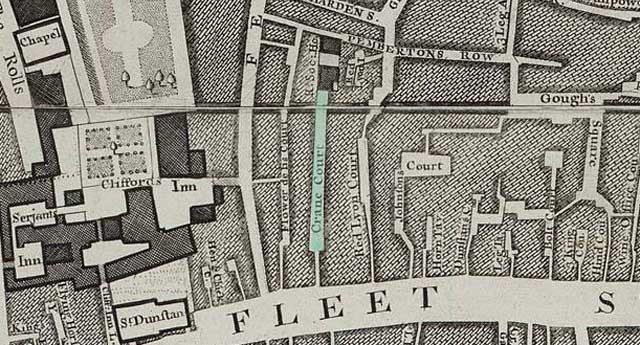Join us as we venture into the back passages of London...

Where? Western-most alley in the veritable circuit board north of Fleet Street, from which it communicates with Fetter Lane.
What? There's very little life down Crane Court these days. A solitary Indian restaurant (the Temple Bar) is about the only feature of interest in an otherwise unremarkable passage lined with offices and fire exits. But travel back 300 years and this humble alleyway would have thronged with the nobility and great thinkers of late Stuart and early Georgian London.

From 1710 to 1780, Crane Court was home to the Royal Society, the oldest scholarly association still in existence. The premises can be seen clearly in the Rocque map of 1746 (see below), forming a cul-de-sac at the northern end of Crane Court. The complex contained a meeting hall for Society members, a Wren-designed repository room, plus a library, garden and coach house. Great men of the age, such as Newton, Sloane, Franklin and Joseph Banks would have made regular visits to Crane Court.
A lamp over the Fleet Street entrance signalled that a meeting of the Society was in progress, much as the orb atop Big Ben is illuminated when the Commons are in evening session. The Society moved out in 1780 to take up larger accommodation at Somerset House. They've also resided at Gresham College (their original home, on the site of Tower 42), Burlington House and their current home on Carlton House Terrace.

Because of its scholarly associations, Crane Court is one of the few passageways in the world to play a major role in a work of fiction. The System of the World, Neal Stephenson's epic conclusion to his Baroque Cycle, is partly set in the Court, which suffers a terrorist attack from a phosphorus bomber in the opening chapters.
The Court also features prominently in the history of publishing. The magazines Punch and the Illustrated London News both began in premises on this site and it also served as a hub for illegal publication of unstamped newspapers.




